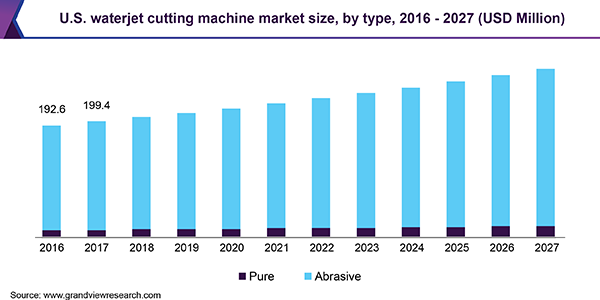Waterjet Cutting Machines Market Growth & Trends
The global waterjet cutting machine market size is expected to reach USD 1.4 billion by 2027, registering a CAGR of 5.1% from 2020 to 2027, according to the new study conducted by Grand View Research, Inc. Growing advancements and innovations in the waterjet cutting industry has led to the development of robotic waterjet cutters, which has contributed to improving the operational efficiency across various sectors. Moreover, the innovation of pumps from traditional intensifier designs to fast direct drive pumps coupled with the enhanced nozzle designs to provide improved cutting rates can be attributed to the increased demand for waterjet cutting machines.
Furthermore, the intricate design of aerospace and defense components which require high precision and accuracy in terms of dimensions can be achieved through the machines, which has compelled the manufacturers to focus on product development. For instance, in 2017, OMAX Corporation introduced its latest generation of MicroMax series, a micro-abrasive waterjet technology which has a positioning accuracy of less than five microns. Additionally, benefits such as cold cutting method, no generation of hazardous waste, and a cleaner finished output has led to the adoption of the machines in various applications such as the healthcare industry, semiconductor manufacturing industry, packaging industry, and mining industry.
Increasing demand to cut, drill, shape materials into precise sizes without producing wastes has been the key factor compelling the companies to adopt the technology. The cutting process does not lead to the creation of any hazardous waste and further facilitates the recycling of scrap materials. Thus, resulting in environmental benefits and enabling the end-use industries to adopt the technology. Moreover, with the increasing stringency of environmental standards and waste production limitations, the waterjet cutting machines market is anticipated to witness robust growth over the forecast period.
The machine provides benefits such as cost-effective operations, no metal distortion, and a cleaner finish as compared to the other cutting techniques such as plasma, laser, stamping, and electrical discharge machining (EDM). As a result, the machine can be used for cutting nearly any composite or material, thereby driving the market over the forecast period.
